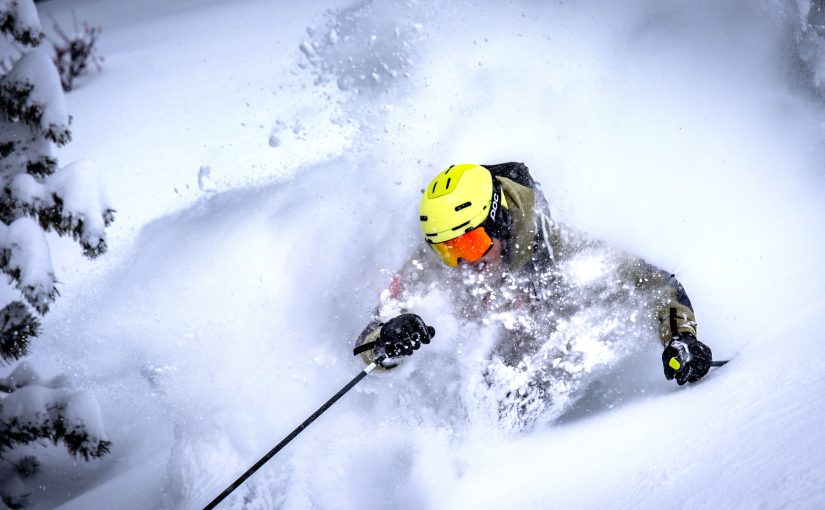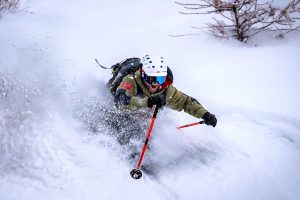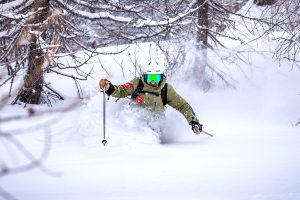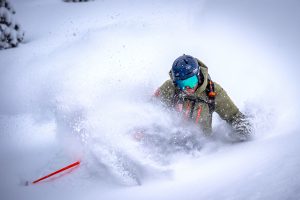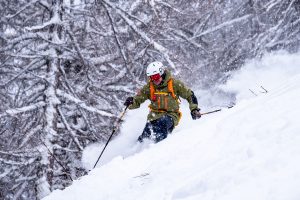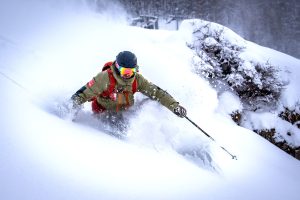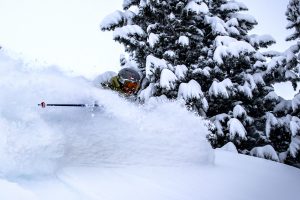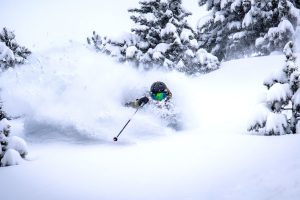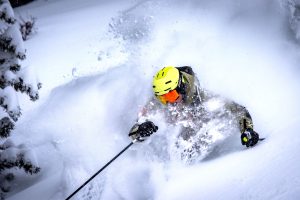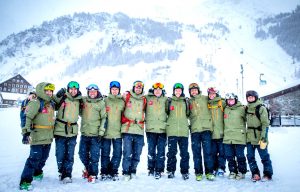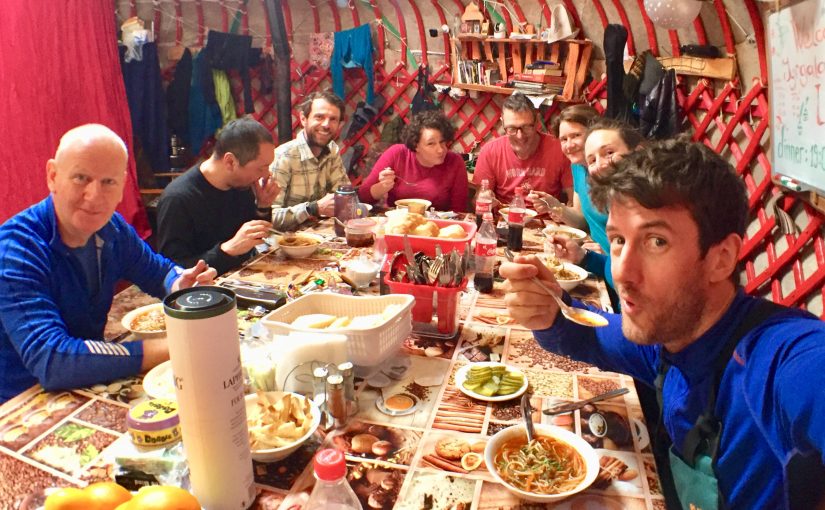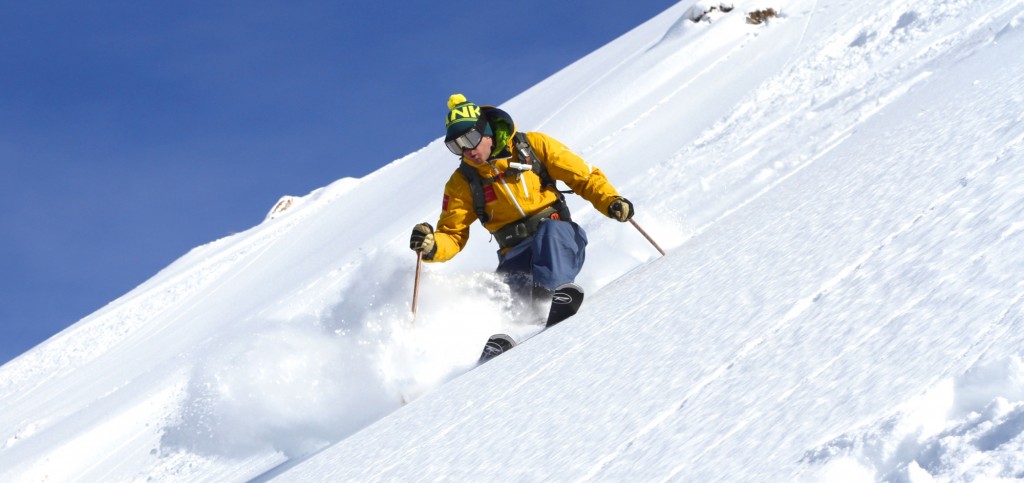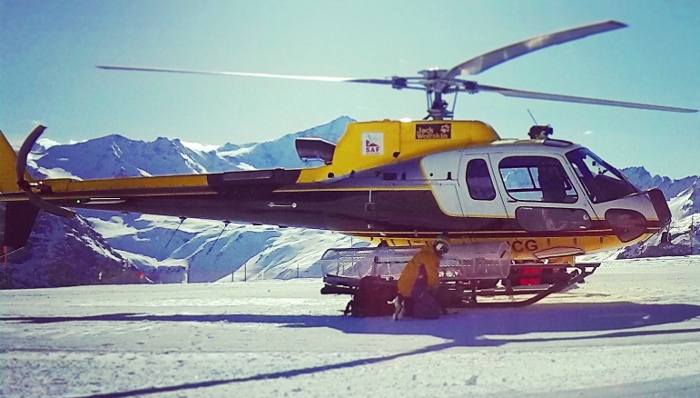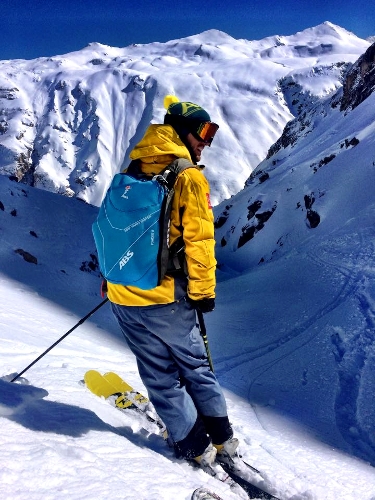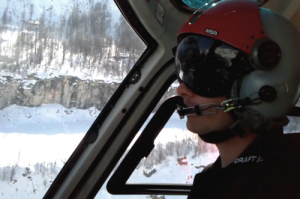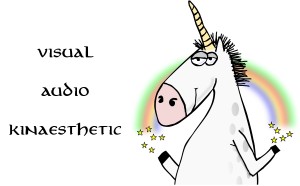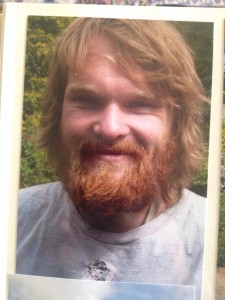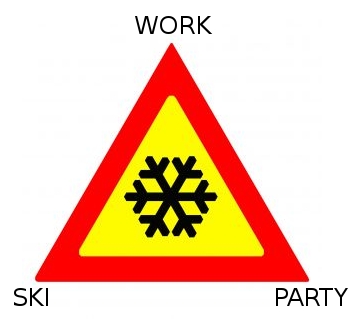Have a look at some of the great images we got on Val d’Isere opening day 2nd Dec 2023.
Photo Credits – Tony Wilkinson Photography
Tag: val d’isere
Spring Skiing Can Be Hard To Beat
Kyrgyzstan Ski Touring 2020
Terry, Rich and a team of 6 clients recently returned from ski touring in Kyrgyzstan, this is part of their TDC Expeditions endeavours. Check it out for next January/February 2021!
The trip starts with the team meeting in Istanbul airport ready to fly together to Bishkek, the beautiful capital of Kyrgyzstan. A short (6 hours) transfer past the drainless lake Ysyk-kol leads to the sleepy ‘village’ at the upslopes of the Tesky-Ala mountains of the Northern Tien-Shan Range. Here are the base Yurts for the first 2 days of ski touring.
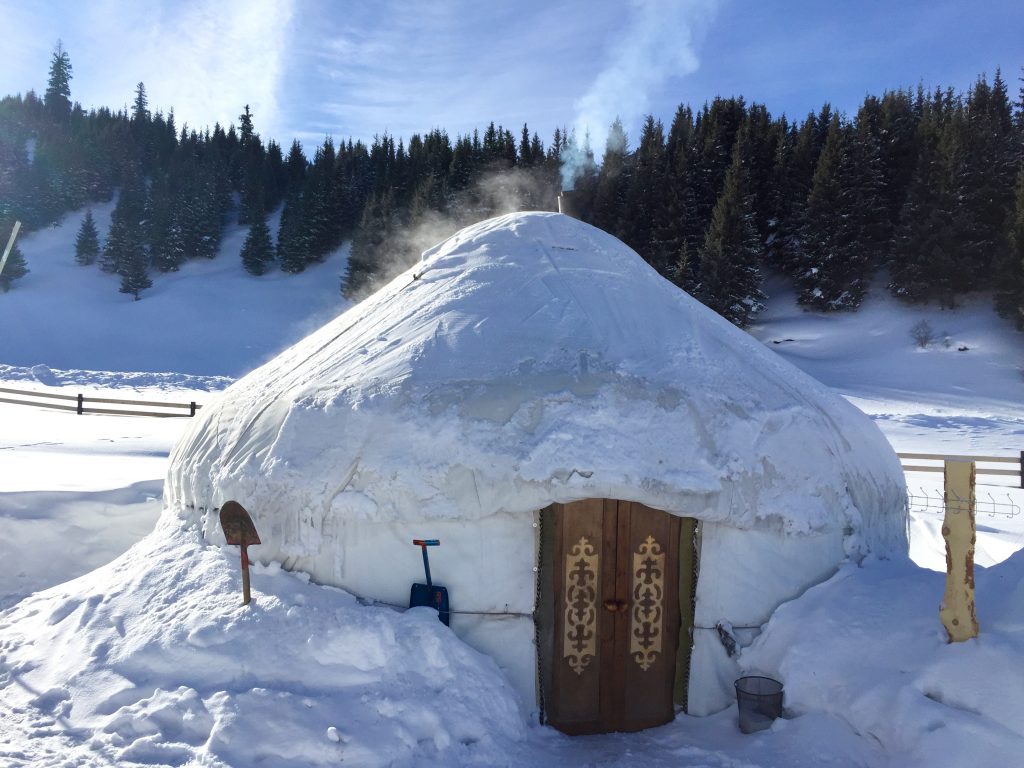
The terrain around the camp is gentle and sparsely forested. Perfect for an introduction to ski touring skills, familiarisation with the equipment, and acclimatisation. The snow is guaranteed to be cold and dry, a mixture of powder and old faceted crystals that ski beautifully.

Temperatures overnight of -15/-30 soon warm to -5 which is perfect for the daily ascension of about 350m, or 1.5 hours in the morning to a perfect spot to cruise the powder back to the yurts in time for lunch.
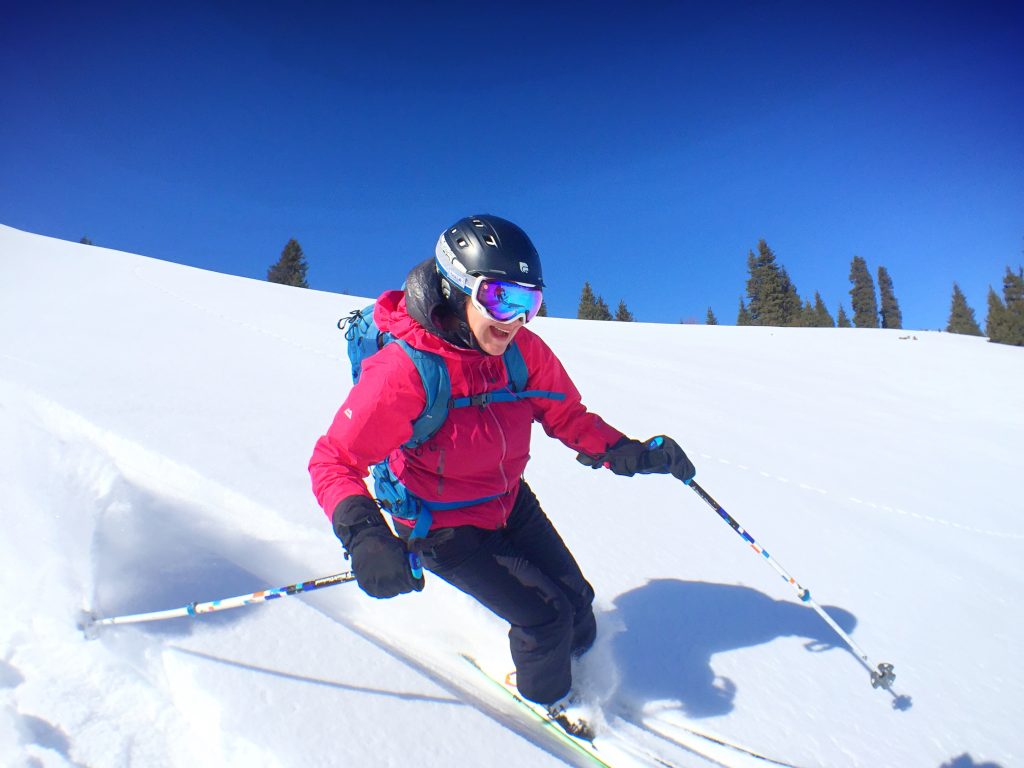
The afternoon holds a similar pattern, with usually an hour of peaceful uphill followed by a mind-blowing descent back to camp. It’s rare to see other tracks, and even more so to ski near them!
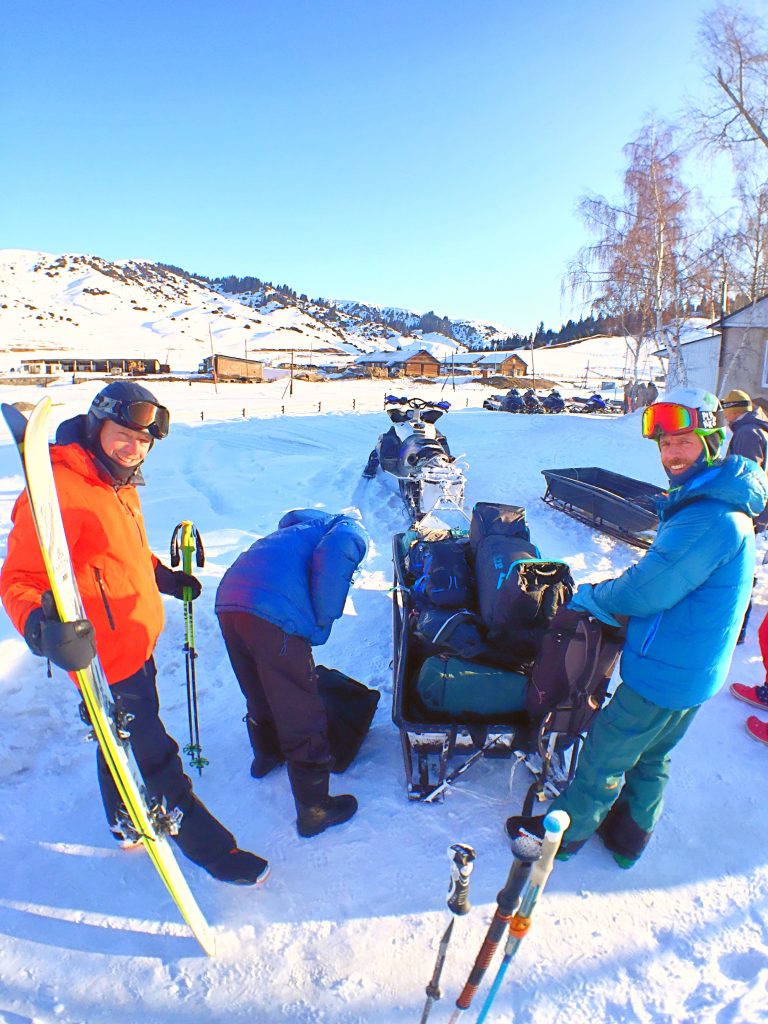
The advanced yurt camp is truly isolated and requires a 45-minute ski-doo commute to arrive. Passing incredible scenery along the way… but concentrate as ski-doo drag skiing is not for the faint-hearted!
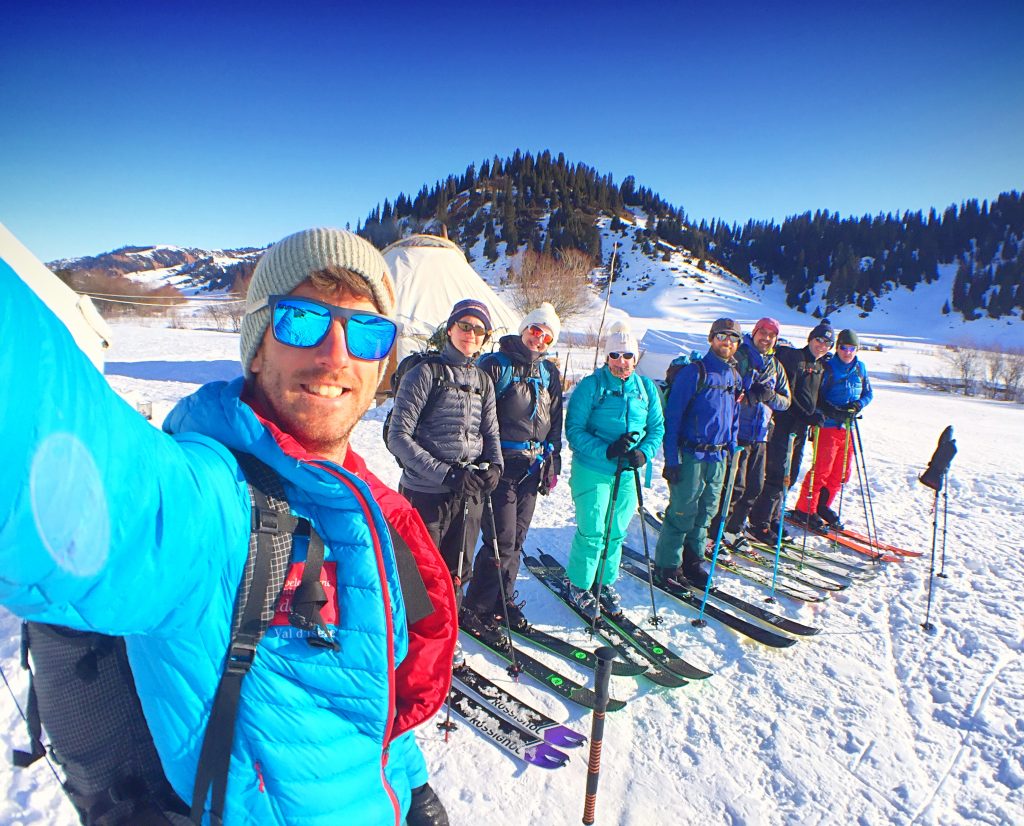
With 3 days out of signal/reception/wifi under the stars at the advanced camp, everyone becomes truly relaxed and collectively didn’t want to leave. The sauna provides the end of each day before dinner is served. 2 courses, including a soup/broth to start and then a mixture of different fusion cultured meals each night. The food is outstanding.
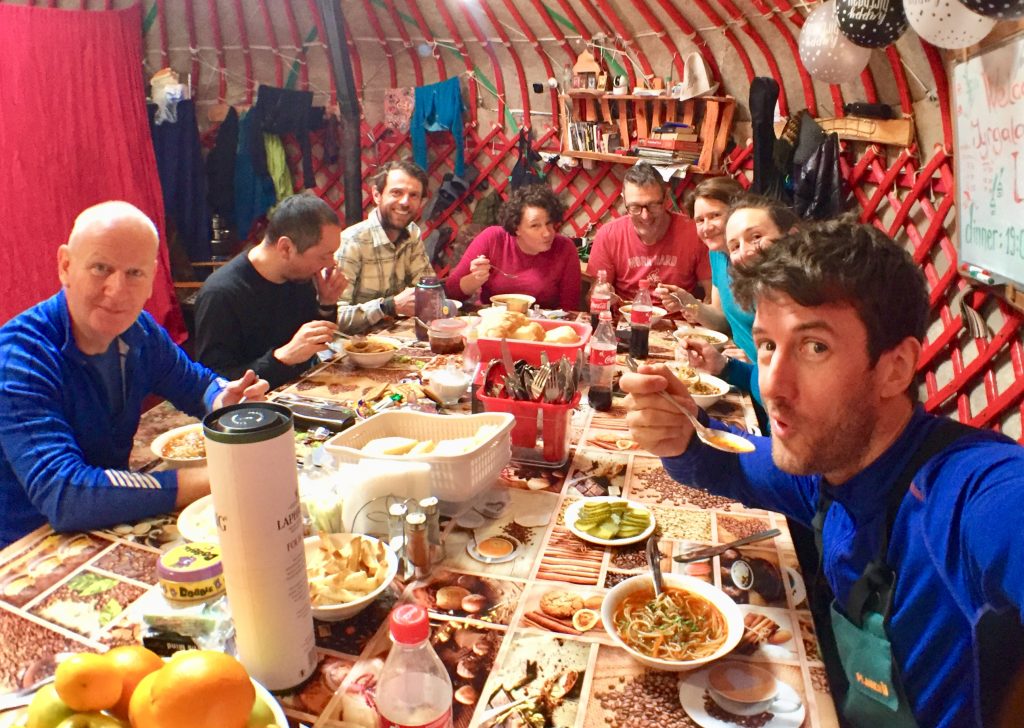
The evening’s entertainments involved Terry playing the guitar, Rich falling asleep playing cards, and the team drinking a tad too much fine whisky, rum or vodka… every night!
The trip finishes with a trip to the hot springs located near the central lake of Kyrgyzstan, an eye-opening stop to get superb lunch at a ‘motorway’ services, and then a night in the best hotel in Bishkek. The restaurant for the final meal has incredible feasts to share, this year involved 4 courses, and almost ordering the correct amount of food. Half the team could deal with the soured milk, half couldn’t bear it!
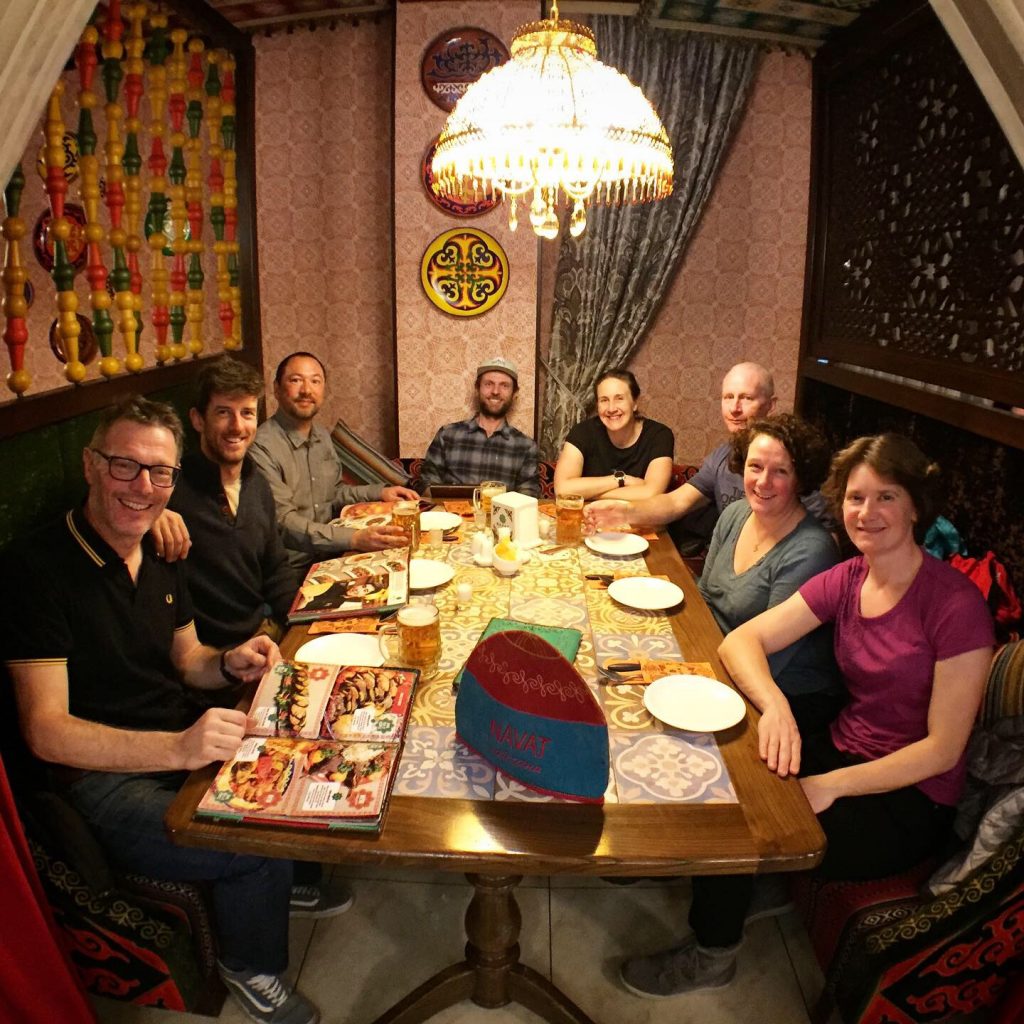
Thanks to everybody that came and made it such a special trip. We’re seriously looking forward to next year… and if you’re interested, check out the website for this trip or more.
Making the Most of the Pistes
Except for the hard-core ski tourers, most skiers spend a lot of the time on the pistes. To make the most of your time on the pistes you need equipment in first rate order. Then allow the skis to do what they are designed to do. With rockered skis, fat waists and twin tips, it is easy to forget that carving skis revolutionized skiing and piste skiing is where that happens best.
Can your tools handle the power?
Some of the best feelings in skiing are found on the pistes. The power of a carve turn can be incredible, and generates up to 4G in force. Any ski can carve a turn, but to maximise the experience you need a ski which can handle the power. Dynastar’s WC Master series have serious pedigree, coming from their race factory and the Speedzone series make the carve turn easier to achieve.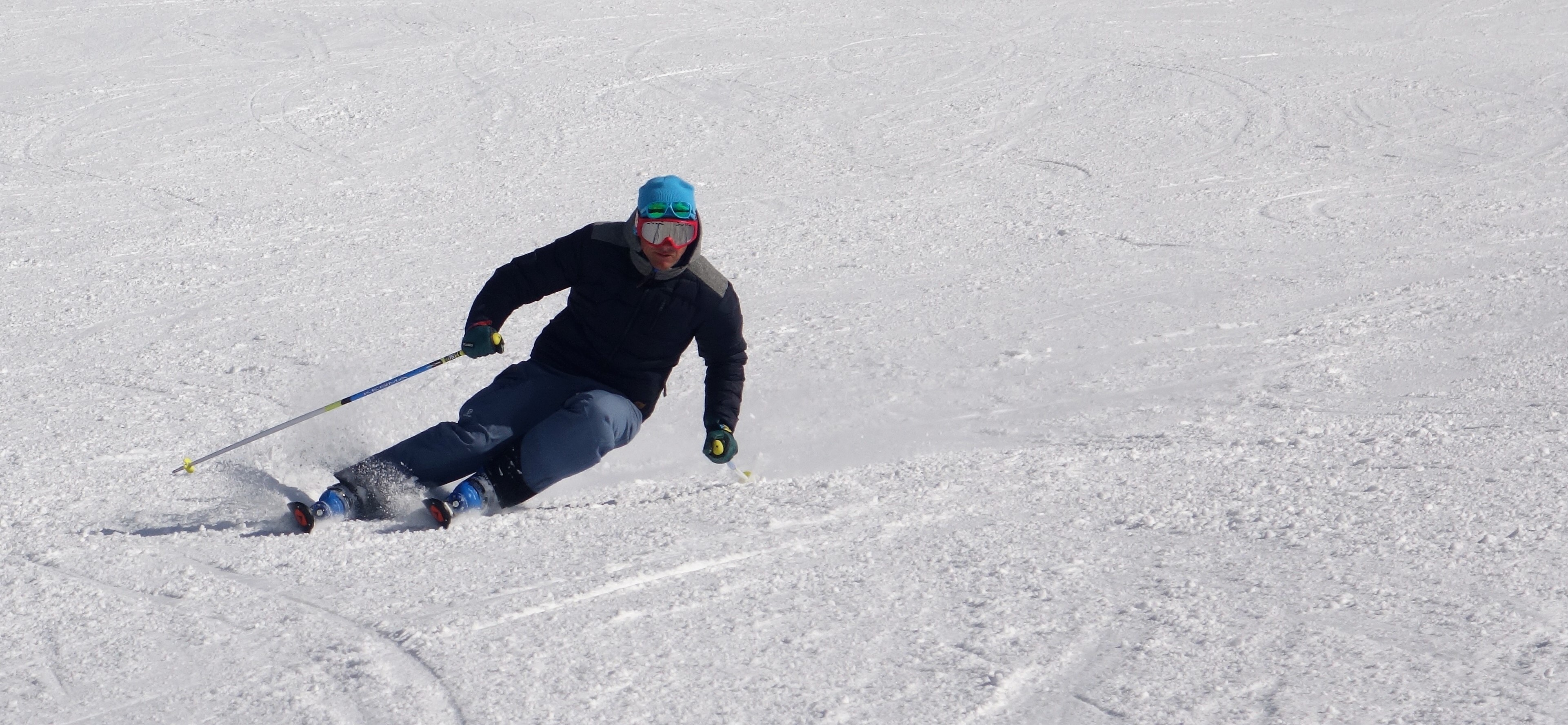
Are your skis sharp?
The key to carving is tilting the skis over and balancing against the forces generated by the turn. The more you can tilt (and stay in balance) the greater the forces will be. In order for the skis to grip when tilted over on firm pistes the skis need to be in good condition. Sharp edges and a smooth base is essential to build confidence in your ability to tilt over. Get your skis serviced before heading to the alps and at the minimum take a diamond edge tool to keep the skis in great condition whilst you are out there.
Just tilt
If you want to turn tighter in a carve, tilt over more and allow the skis to move further away from the body. Balance through the outside ski and tilt both skis the same amount. High speeds are the result of carve turns so only practice when and where it is safe to do so. You’ll definitely need goggles (not glasses) to stop your eyes from watering and a helmet completes the racer ready look.
As with everything in skiing, deliberate practice in a suitable environment will see you improve your performance, and carving is still one of the great unused techniques in skiing. For more help book yourself some lessons on your next trip.
Giles Lewis is an ambassador for Dynastar skis and Lange boots. He is a ski Instructor with the development centre, who operate in val d’isère Tignes and the Three Valleys, France. He is a trainer and examiner of Instructors for BASI and a member of the British Demo team.
www.tdcski.com #tdcski #basi #valdisere #dynastar #lange
Jan 27th 2017 Snow Conditions Val d’Isere Tignes
This week Clare is telling us all about the current snow conditions in Val d’Isere and Tignes…
Conditions On Piste Are Fantastic…Again
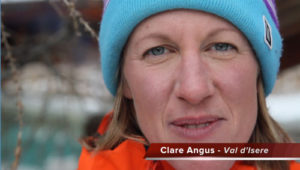
Dustings of snow, Off Piste is good, can be wind effected, some good snow in the gullys.
Things are looking good for February.
Watch a honest and open summary of the current snow conditions.
If you are keen to see this seasons reports then be sure to watch out for them on Facebook, Twitter, YouTube and Vimeo.
Keep Watching!!!
TDCski The Development Centre – Ski Lessons Val d’Isere – Ski Lessons Tignes
How to Find Spring Snow – Off Piste in Val d’Isere
After a bonkers couple of weeks of winter weather, the cold fluffy powder is restricted to the high north faces. But don’t fret. We have warm settled conditions now and my 2nd favourite type of snow – Spring Snow. It can be hard to find and get it good, so here is Coach Kieran explaining:
What is it?
When the sun thoroughly heats the snow pack from the surface down to the earth, the prevalent moisture spreads uniformly across it’s depth. Given the right temperatures, this freezes solid in the evening and over night. The next day the sun can heat up the top inch or so, creating a ‘corn’ feel, on a firm base. It’s great to ski and potentially quite safe.
Problems?
To early = smooth, slick, solid ice. Both dangerous and uncomfortable.
To late = slushy to the base of snow pack. Serious avalanche territory.
Too few cycles = bumpy, other skiers tracks, variable depths, variable thaw rates.
So what do you consider when finding Spring snow?
- Timing: at 09:00 most of the East faces (Belvarde, Borsat, Charvet, etc) have been in the sun for a few hours, and given time to absorb those rays and soften. South faces late morning and lunch time. West faces are best in the afternoon.
- Temperatures: The previous afternoon needs to be hot enough to melt out the other tracks and uneven nature of the slope. This will hopefully be +5 ish with direct sunlight. Overnight, the colder the better -5, brilliant. Especially with a deeper snow pack. As soon as the temperatures approach 0, or go above, combined with direct sunlight the snow will soften. It may be a short window of 1 hour to hit the slope at the right time.
- Cycles: The more melt freeze cycles, the more compact the snow will be, and the fewer skiers tracks from previous days. This makes the snow and slope as a whole more predictable, and safer as it’s glued together at the bottom.
- Aspects: The sun rises due East on the 21st March, and sets due West. After that date, it rises gradually more North East, but still takes a trajectory around the south of the sky. So North faces will remain mostly in the shade for the season. Southerly facing slopes at this time of year take a beating from the high sun. Take for instance the Fontaine Froid; probably the first slope to run out of snow at the end of April.
- Angles: A slope will absorb more sun if it directly faces it. A very flat slope will be softened less than a 40 degree slope. Especially early East faces, and late West faces.
- Slope base (anchors, rocks, grass, smooth slabs): This is a safety point more than anything. Rocks in the snow pack create pockets of air, and they heat up in the sun. A slope dotted with rocks is probably more unstable at this time of year than a big open white slope. A shrubby, or large scree based slope will have better anchors to hold the snow from avalanching than a smooth rock slope or fine grassy slope.
- Altitude: This will usually relate inversely with the temperature, unless there is a pressure/temperature inversion in which the valley is colder than the high mountains. Generally the higher you go, the longer it takes for the Spring snow to transform from hard icy snow.
- Wind: The same conditions as the day before mean very little if the wind is 5mph stronger. Slightly more wind can slow the transformation by more than an hour, and can stop it all together.
- Cirrus Cloud: That very hazy, high level cloud that slightly dims your shadow. This can have a massive effect by absorbing the suns rays and stopping the transformation.
There are countless other factors to consider, especially when managing a group in this kind of terrain, but these are the main contributors to good snow.
Always carry at least a Transceiver, Shovel and Probe with you. We hand these out for use during our Spring Clinics, where you will be guided to cool spots, educated in finding good safe snow, and improve your technique!
Be safe, and try to get out for some high altitude resort fun in Val d’Isere over the next few weeks… We have spaces on our group clinics. The snow is amazing, the lifts will be dead quiet, and the sun is out!
HeliSki in Val d’Isere, France
In the Vanoise national park that incorporates Val d’Isere and Tignes, TDC coaches and clients ski to extremely cool and inaccessible places, then get a helicopter back out. Being dropped on top of a mountain is not permitted in France, but getting picked up in certain places at the bottom is fine.
Some of our coaches have had the requisite training and been signed-off allowing them to call in the helicopter and arrange the pick up. Amongst other things, this entails stacking skis, pacing out distances, and sticking your arms up in the air facing the correct way (over simplified).
Destinations that the development centre heliski guide / instruct to include:
Lac du Chevril – big dammed reservoir below Tignes, usually via an exhilarating route down.
Bonneval – over the back of the Pissillias Val d’Isere Glacier and down the other side.
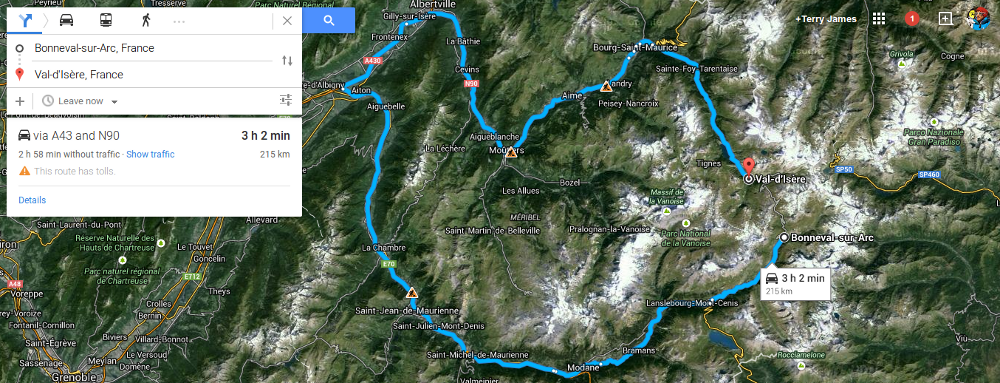
The heli pilot (undoubtedly the coolest looking guy I’ve ever met) can then drop back to the top of Solaise, bottom of La Daille, or in Val Claret to continue the off piste experience.
If any of this takes your fancy, then speak to our office [email protected] about arranging a half day trip (instructor and heli) from 340eu, or just bolt on a helicopter ride to your already arranged lesson, from 115eu
Bon Ski!
“Perfect day! Couloir & chopper action – tick! Thanks TDC” – Fliss
“Best day skiing of my life!” – Holly
VAK Learning styles – Very Awkward Knowledge
Visual/Audio/Kinaesthetic (VAK) gets banded around loads, even at the top levels of Ski Teaching. I’ve often kept quiet, not to rock the boat, as somebody talks ‘knowledgeably’ about it. A paper from 2008: click here illustrates the dearth of worthwhile experiments that have been carried out in this area of psychology, and references papers that have contradicted this learning theory all together.
Please stay open minded reading the paper and this blog. Remember that opinions are great, but science doesn’t really care about your opinion or anecdotes, unless they involve double blind randomised testing with high numbers of trials/participants 🙂
The Pashler et al. paper states that the VAK thing has gained much influence in the world of education, and I’ve seen that it definitely exists in the realm of ski instruction. The paper finds that both children and adults do have learning preferences, but these usually don’t match up to their most effective method of learning a particular subject. Also, of the huge amount of academic literature on the subject of learning styles, very few experiments were capable of testing the VAK hypothesis with validity and those that did contradict it.
You may be thinking “a lack of evidence doesn’t disprove the hypothesis”, but disproving things is tough and sometimes impossible. For instance; we have a lack of evidence for unicorns being able to ski, as we’ve not witnessed it… it’s not disproved. But white-horned-horses carving turns, is as unlikely as Echinacea preventing bruising. Ice prevents bruising, you can test it (punch yourself in both eyes, and apply echinacea to one and ice to the other – monitor results). Why don’t all ski teachers try where possible to use evidence to improve the performance and enjoyment of their clients?
Well, we do (and not to the detriment of fun, enjoyment and happiness). Time would be wasted trying to figure out if my clients have Visual, Audio of Kinaesthetic preferences; if they do, they’re probably wrong, or I’m wrong in assessing it, and it more than likely has no relation on how they’re going to learn best anyway! Crazy eh.
Do we teach using VAK analogies, descriptions and explanations. Yes. It’s a diverse and interesting way to mix up a lesson. Those who’ve been in my coaching sessions may have heard me describe momentum/kinetic energy transferral causing snow displacement thus creating sound waves that we can hear! Everyone can understand my squiggles in the snow, followed by the sound of the turn, and the feeling of the ski under their foot. Boom, there’s VAK all in a one-er. Maybe it is more valuable to utilise a teaching method according to the clients weakest/least preffered aspect of VAK learning. Who knows?
It is definitely far more appropriate to to use a visual lesson when describing how to take a high line in the gates. By drawing lines in the snow, or getting people to watch an example. Whereas it’s more important to be auditory in explaining that someone can’t get their foot in the binding because the heel piece is in an upward position. Attempting to get one’s weight centred across the sole of one’s foot is impossible to listen for!
It may take a while for ski instructing examining bodies to get on board with not talking about this, so if you have an assessment coming up, be nice to the trainer and point them in the direction of http://scholar.google.com Because telling people that their theory is debunked doesn’t always go down well. Trust me.
Terry – these are my own words and not necessarily the views of the development centre as such… though the team whole-heartedly agree with my adoption of evidence based practise, where possible, in teaching skiing.
Sleeping in your car for a Ski Season
At the start of this season in Val d’Isere, the TDC coaches were invited to welcome drinks and canapés at various high class chalets dotted around this prestigious resort. Oysters, cavier, mini hamburgers, mini yorkshire puds with roast beef, washed down with plenty of Champagne and vin rouge.
Things were not always like this for us… Coming through the instructor ranks and modular exams to reach Level 4 ISTD, most of us were a bit strapped for cash flow at some point, if not the whole ordeal.
Steve and Charlie, each braved a season in their cars to keep the expenses down. Whilst I slept in my car, or pitched a tent for all of the modules that I could take back in the UK. Here are some lessons learned, funny stories, and off putting reasons to do the same:
I remember being on my Level 1 course in at an indoor slope, and spending the 5 nights in a layby of an A-road 10 minutes from the centre. One night I heard a very very loud tap on the window by my face and awoke to a policeman shining a torch in my befuddled eyes. It was one of those wake ups where your heart can’t quite keep up with all the adrenaline and starts to thump so hard you think you’re dying. “What you up to?” said the copper… In my heightened state I replied “sleeping you idiot, what do you think I’m doing?”, somewhat surprised and affronted the copper states “oh, like that is it. Well I thought you might be paying your road tax which expired last month!”
Another cold wet night, I emptied my pockets onto my roof (slept in trousers for warmth), before starting the faff of getting in my sleeping bag having removed my shoes without banging my or getting feet wet on the gravel carpark. Forgot all about the wallet and phone on the roof until I saw them disappear into oblivion down the motorway the next day! -Terry
So when little Steve wanted to grow up into a good looking, skilful, tanned and inspiring ski instructor, he set his sights on working in the ‘jewel in the crown’, aka Val d’Isere. Money was tight and his pockets not deep enough, so being an enterprising person, he hatched a plan; save money by living in his Citroen BX Estate car for the season and offering people transfers to and from the airports for pocket money. What could go wrong…
In the middle of the night he once got locked out whilst ‘watering the plants’ (the good old days of unreliable central car locking) and had to smash a rear window to get back in, and by the morning a blizzard had buried him alive in his car.
He regularly wore 15 layers to sleep in, on top of dirty clothes, towels and spare bedding all inside his sleeping bag. In the morning it was a surreal experience to ‘strip’ off to go skiing! This all kept the ‘drive to succeed and qualify as an instructor’ alive.
In the good old days of the 1999/2000 season you had the luxury of being able to use your season pass to access the swimming pool, so showering and shaving and finally warming up was the daily ‘luxury’ for young Steve. Spending the millennium in the car was perhaps one of the most unique ways of spending the most ‘memorable’ of nights on record! Make sure your drink ‘short’ drinks rather than pints so as to avoid middle of the night loo stops, but most important of all; learn some chat up lines and practice them regularly! -Steve’s parents never/don’t know about all this…
The vehicle that stepped up to the task of an alpine residence for me (Charlie), was a trusty Peugeot 406 diesel estate. And from my wealth of experience it’s worth noting that 8hrs sleep won’t cut it, 10-12hrs was the norm for me. 9pm-7am was quite common without so much as rolling over. I put it down to breathing in cold air which I presume makes your body work harder.
We all have low points but living in temperatures down to -35 C, you can encounter some rather interesting ones! After quite a skin full I somehow made it back to the Pug, although it would have been better if I hadn’t. Sometime in the middle of the night I decided to relieve my uncomfortable sleep by opening the boot for some extra fresh air. In my slightly compromised state I missed the fact there was a snow storm going on. It’s not often one has to dig through snow just after waking up. Once breached, I realised that the entire car was full of snow, to the ceiling at the drivers end, then gradually slopping down to the boot! The whole of the next day involved removing snow and desperately trying to dry bedding before the next night, all with a raging hangover.
Aside from the air being rather chilly, any food freezing and the struggle to keep your drinking water in liquid form, one has the joy of condensation! This is quite a problem after a time because the water vapour from breathing, coats everything in moisture which freezes, layer after layer. This simply keeps on building up unless removed. Opening the window does little to slow the process and that’s a rather bone chilling method (see above). Here is where I invented possibly the greatest solution to a problem since getting a paid job. My answer to condensation was a medical face mask with two tubes containing one-way valves. The air I inhaled was drawn from the inside of the car and the moisture ridden stuff that was exhaled, diverted down the other tube which made its way to the outside, resulting in a dry car! How I failed to make my millions from this I’ll never know.
It’s refreshing not to have a fixed post code but it does mean the neighbourhood can vary, at times for the worse. In some resorts I would cycle everywhere and this means having a bike locked to a wheel. If you didn’t already know, drunken people love bikes, a lot as I found out. Every few weeks I would hear a confused, intoxicated individual tugging at my bike. This should have sparked fear into me but instead this was a time of hilarity. I would creep toward the driver’s seat, put the key in, set stereo to come on at max volume, the lights to come on when I start the engine and get ready to press the horn at the same time. The reaction on making all this noise to the unsuspecting bike borrower was priceless. Often knocked off their feet or bouncing off the car opposite they would then gallop off through the car park. The only negative side effect to this technique was that I would struggle to sleep again through laughing to myself.
The first question asked when talking about this way of skiing is why?! Why suffer in a car for weeks on end just to get in a few extra hours of snow time:
1. I had an obsession with skiing and was willing to do anything stay out. I dreamt about skiing, watched countless ski films and researched much of the history of skiing especially in the off-piste arena.
2. I had almost no money and couldn’t wait at home for savings to build up while winter was in full swing. It sounds silly that I couldn’t just have saved a stack of funds to live normally but I just couldn’t bring myself to wait, especially once I had the bonkers idea of roughing it.
In conclusion, if I was faced with the same situation, with the knowledge I have now, I wouldn’t think twice about making a reservation in the Peugeot hotel. -Charlie
Ski Resort Jobs – to becoming a Ski Instructor…
The TDC team have a great deal of experience in ski resort work from before they became qualified ski instructors. We gained valuable experience (and stories) along the way. Offices aren’t for everyone and the daily grind of academia can get you down too – so why not pack a bag and become an instructor? If you choose somewhere like Val d’Isere, then it’s likely you’ll be thinking about part-time or full-time work to fund the training and exams required to achieve the highest qualification in ski teaching.
Popular Option: Take part in a GAPski course for your Level 1 & 2, this will include: accommodation, food, courses, training, free skis and lots more!
Ski Bum with ample savings: you may wish to rent a lovely apartment and do the luxury ski bum thing, getting loads of skiing done, building your skills towards becoming an instructor and maybe taking on a level 3 or 4 course such as these.
Ski Bum with limited savings: you could still do the ski bum thing. But it could mean sharing a studio apartment with five (or more) people! Who generally won’t be keen on washing or cleaning. But you’ll probably be so busy skiing it won’t matter. It’s a great option saving money to put towards those instructor exams.
Ski Bum with extremely limited savings/debts: before talking about getting a job, there is one more option and this should be seen as a last chance saloon; sleep in your car for a season! [There will be a complete blog article on this next week]
Get a job: if funds are limited then there are a number of jobs in resort that will help keep a roof over your head and facilitate moving towards becoming an instructor. There will be three main aspects to your season: work, ski, & party. It will be tempting to try and do all three – though, will quickly become apparent that at least one of these has to give. Best not to let that be work! So really the choice is between skiing and playing.
Chalet work: this is a good choice if you want someone else to pay for your accommodation, lift pass, ski hire, food (& wine if you’re cunning)! The hours are perfect for maximising ski time – once you’ve struggled through the initial hectic weeks, you should be out by 10AM and shredding powder (or practising your snowplough). I worked for YSE and thoroughly enjoyed my time.
Ski rental shop: also a good option – all the better if you can work 30 hours over just the weekend! Get some sleep and you have 4 days off! You’ll work with all the gear, and hopefully end up having some idea. These hours also count towards those required for your BASI level 1/2 qualification. Snowberry is a good bet.
Ski school office: You’ll find out everything you need to know about the inner workings of a ski school. You’ll have access to free lessons and advice, be able to work out the ups and downs of life on the hill and learn first-hand about the trials and tribulations of the long winding road of instructor exams.
Stagiere / Trainee Instructor: It’s possible to work for a French ski school as a stagiere with a BASI Level 2 and test technique pass (slalom race). This is a great job and the ski school will usually offer plenty of support in finishing your diploma.
Other options: Bar work – if you can make sure you don’t party too hard after your shift you can still manage a good day on the hill. Waitressing work – ditto. Nannying – limited skiing, unless work is thin on the ground and then limited funds. Driving – you might find yourself working a lot when the lifts are open. Chalet maintenance – good choice, only if the chalet is falling down do you really need to curtail your ski day. Band/Solo musician in bars (tres cool).
Whatever you decide to do, whatever route you take, the key is to maximise ski and exam time – some jobs lend themselves to this more easily than others and some companies too. Do your homework about expectations so the job’s and yours meet somewhere in the middle. Working for TDCski, the development centre, we are all qualified to the highest level BASI 4 ISTD, with French equivalence. If you get the balance right – work enough to live, play a bit and ski ski ski… you could be teaching on the slopes in France too.
Coach Clare is currently teaching fulltime with tdc, after having a beautiful baby last April, managing the two is proving tiring, but probably nowhere near as tiring as her season as a chalet girl! [ed]
